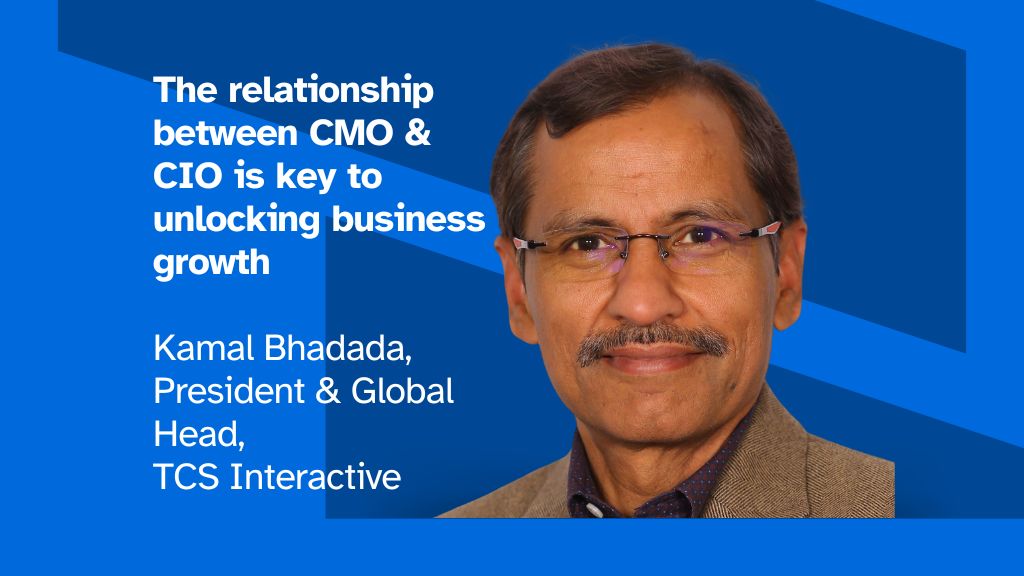By Kamal Bhadada, President & Global Head of TCS Interactive
In an accelerated digital landscape where technology and marketing are becoming increasingly intertwined, creating synergy between chief marketing officers (CMOs) and chief information officers (CIOs) has never been more critical. However, CMO-CIO engagement ranks lowest among C-suite executives according to our recent study, “The Future of Growth: Unlocking the CMO-CIO Partnership,” which was done in partnership with the Institute for Real Growth (IRG) Impact Study. In fact, fewer than half of CMOs report having an effective collaboration with their CIO counterparts.
This disconnect poses a significant challenge to business success. The study found high-performing companies* recognise the value of cross-functional collaboration and in harnessing technology, not only to leverage insights from the past, but also to forecast future opportunities and potential obstacles. Our findings show that over two-thirds (67%) of overperforming companies have strong CMO-CIO relationships, demonstrating that effective partnerships can unlock substantial growth. But to establish these alliances, companies must first navigate alignment challenges.
(*Overperformers are companies that outperform competitors on various strategies such as breaking down silos that have also proved stronger on top-line revenue growth during the last three years, according to the IRG study.)
Bridging the collaboration gap
The gap between CMOs and CIOs typically stems from differing priorities. The CIO focus has been on building and maintaining IT infrastructure, and many of their C-suite counterparts—particularly CFOs and COOs—have quickly aligned. The digital transformation of those functions requires working collaboratively with the CIO and building cohesive relationships to optimise efficiency and spur company growth.
However, the CMO has often remained more focused on collecting customer insights and identifying market trends, which can lead to a limited understanding of the technical complexities and infrastructure concerns that are paramount for CIOs. Conversely, CIOs, tasked with modernising and maintaining robust, secure, and efficient IT systems, may find it challenging to grasp the fluid dynamics of customer behavior, key performance indicators, and market demands that CMOs deal with daily. This lack of understanding of the pressures of their respective roles can breed frustration, creating tension and impeding opportunities to work collaboratively.
The rapid advancement of AI technologies further complicates matters. While many organisations are optimistic about the potential of AI to enable major marketing technology (martech) successes, siloed communication between marketing and technology departments can create roadblocks to effective dialogue. CMOs might see these AI advancements as opportunities to gain deeper customer insights and drive growth, while CIOs may view them as added pressure on already strained IT infrastructures and budgets. Moreover, these two organisations often operate independently, with distinct goals, strategies, and performance metrics, creating barriers to effective communication and further widening the gap to collaboration.
Five drivers of successful alignment
The TCS study and the IRG has identified five key drivers for an effective CMO-CIO partnership: Ground, Reimagine, Focus, Organise, and Unleash.
- Ground involves aligning IT and marketing roles, bridging gaps between ambitions and capabilities. It also requires a joint learning agenda between the CMO and CIO, and both must be willing to invest in the partnership. Also, it is essential for both to learn about external partners and the role they play in the convergence.
- Reimagine calls for a future-backward vision for marketing and technology, then working backward to achieve it, as well as a long-term strategy to deploy martech iteratively.
- Focus emphasises the need to embrace joint KPIs and a holistic martech strategy that differentiates between transformative and adaptive changes, ensuring IT solutions and jointly created budgets align with business objectives.
- Organise starts with aligning on current and desired levels of convergence across the ecosystem. This approach enables the creation of balanced, whole-brained teams where creativity and analytics are equally valued. And to support this culture, the CMO and CIO should be jointly involved in hiring key recruits.
- Unleash highlights the importance of personal leadership and taking ownership of partnership success. It is essential to model positive behaviors of the partnership, endorsing and celebrating each role’s successes, and progressing together on the functional interdependence benchmarks.
Ultimately, the goal is alignment. CMOs and CIOs may previously have been able to work independently, but today’s marketing landscape is more competitive than ever. If technology resources and expertise are not being used collectively, to an enterprise’s advantage, it will fall behind. The most successful organisations are able to effectively collaborate leveraging AI as a leading-edge technology.
Real-world examples of marketing and technology collaboration
L’Oréal’s Beauty Genius App leverages data and technology to deliver hyper-personalised recommendations, enhancing customer engagement. Similarly, General Mills uses AI to enhance customer experience and operational efficiency, laying the foundation for further innovation and growth.
Create a culture of mutual benefit
The study shows that overcoming the collaboration gap between CMOs and CIOs requires a dedicated commitment to foster mutual understanding, align goals, and promote cross-functional collaboration:
- Both parties need to invest time in understanding each other’s roles, responsibilities, and challenges. This might mean regular joint meetings, shared learning opportunities, or even job shadowing experiences.
- Aligning goals and incentives is crucial. Instead of operating with separate objectives, CMOs and CIOs should work together to establish shared goals that reflect the intersection of marketing and technology. These could include improving customer experience, driving digital transformation, or leveraging data analytics for decision-making. Shared goals can help ensure that both parties are working toward the same outcomes and can foster a sense of shared ownership and accountability.
- Promoting cross-functional collaboration can help break down silos between the marketing and IT departments. This could involve setting up cross-functional teams or projects, encouraging regular communication and knowledge sharing, and establishing joint performance metrics. Such cross-functionality can bolster awareness of the systems operated by the CIO for the CMO. This aids in ensuring the CMO and their team can understand the company’s marketing strategy alongside the layer of systems that sit between their role and the customer. In certain instances, introducing a technical advisor role can support the CMO, ensuring they fully appreciate the implications of the existing technical infrastructure on day-to-day operations. Engaging partner agencies with these cross-functional teams can also be helpful as agencies often work with the CMO to reach the company’s customer audience.
To make all of this happen and overcome the collaboration gap will require strong leadership. Leaders play a critical role in setting the tone for collaboration, modeling effective partnership behaviors, and creating a culture that values and promotes cross-functional teamwork. By demonstrating a commitment to collaboration, leaders can help bridge the CMO-CIO gap and open unprecedented avenues for growth.









